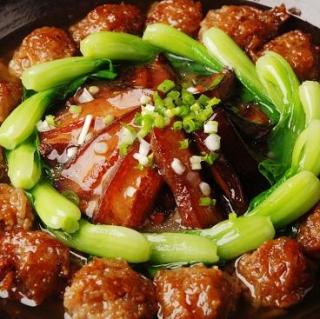
介绍:
更多内容及完整文稿请关注我们10.6日的微信:英语环球 NEWSPlus
Most Chinese people believe that eating isn't just about good food; it's also a social ritual that brings people closer together and helps create harmony within the family. Cooking isn't just a way of processing different ingredients, but also a reflection of local lifestyle and values. Hui cuisine is one such culinary tradition.
Originating in today's Anhui Province, in central China, the dishes of this cuisine are prepared with a precise selection of ingredients, cooking times and temperatures so that textures, colours and flavours are balanced throughout any meal. Our reporter Qian Shan-ming has more.
Reporter:
One of the eight culinary traditions of China, Hui cuisine doesn't refer to Anhui Province dishes as many people mistakenly think but food from Huizhou.
Huizhou is based in today's Huangshan City in Anhui Province. It was a historic region in southeastern China, first established in the Song Dynasty more than a millennium ago. During the Ming and Qing Dynasties, it became one of China's most important economic and cultural centers.
In the same period, Hui merchants became one of the ten most powerful merchant groups in China, and had a strong influence in the country's business circles for about 300 years. It is said that more than 70 percent of the male population in Huizhou back then were engaged in business of some sort, and Hui merchants topped all other merchant groups across China in terms of their number, economic power and the spectrum of their trading activities. Their footprints could be found nationwide, and there was even a saying that said: "there is no town without a Hui merchant."
Its economic prosperity at the same time spawned a flourishing Hui culture which was reflected in every aspect of local life in the late feudal period with its Hui-style architecture, commercialism, the patriarchal clan system, Neo-Confucianism, Hui Opera and Hui cuisine.
'Smelly mandarin fish' is a famous Hui dish which came out of Hui commercialism. Like many fermented foods, the dish assaults the nose but definitely pleases the palate.
Anhui's geographical location is perfect for gathering raw ingredients �C as it is surrounded by mountains and water. That's why the local chefs try to insist on using fresh ingredients and simple cooking methods which mean the dishes maintain the original flavors of the ingredients. So if this is the case, why would a Hui chef use fermented fish instead of fresh for this dish? Food expert Xuan Guolin explains.
"Mandarin fish is not a local product of Huizhou and was, in fact, introduced into the local cuisine by Hui merchants when they came back from their business trips. Back then, merchants had to rely on primitive modes of transport to carry their goods, and trips could take 5 to 7 days or even longer. In these days before refrigeration technology it was essential to find ways to preserve perishable foods like this fish �C so the merchants would slather it with salt so it would keep on the long trek back to Huizhou. When they got home and found the fish had acquired a peculiar smell, they decided to give it a try anyway and bingo, once braised, it tasted great. The taste eventually caught on. "
The fermented mandarin fish shares a pungency similar to blue cheese or stinky tofu, but once you get past the first impressions, you'll be rewarded with a braised flavor that's highly addictive.
It's said that the best time to eat this dish is when the peach blossoms bloom. This is the season when the small river shrimp hatch, become the Mandarin fish's main food source and hence its predator's flavour.
Taste, colour and temperature are all of equal importance in the dishes served up by Hui chefs. Foods are prepared in accordance with tradition-bound principles where the use of high, medium or low heat are concerned, and depend on the characteristics of the ingredients and the objective of the flavors.
Hui chefs traditionally have to master all of the Chinese cooking techniques. Once they have the full skill set, they can prepare ingredients in many different ways, which gives nuances of taste which to many are instantly recognisable as belonging to the 'Hui cuisine' tradition.
And it's not all about a delicate mastery of skills. Hui chefs have to get used to getting a workout -- this strong, savory cuisine demands cooking with heavy woks over huge, hot flames. Wok cooking is a true test of stamina and dexterity and apprentice chefs are trained by tossing sand over and over in a wok. Huohou wei, or "the flavor of the flame", is essential to Hui cuisine, giving dishes a smoky flavor that can be identified in the nostrils of people sitting at the next table.
Huizhou people like their foods to be stewed, simmered or steamed to keep the ingredients' original taste and nutrition; while frying and stir-frying techniques are less frequently used. Some typical Hui dishes are cooked by simmering over a mild heat for more than 10 hours. As Chen Zheng, an expert on Hui culture, explains, this cooking style is closely related to the life values of ancient Huizhou society.
"Confucianism has strongly influenced Huizhou people's attitudes towards life��they tend to stay humble; and emphasise self-improvement and cultivation of virtues; because of this they habitually tend to be relaxed in nature, and peaceful as well. These life attitudes are also reflected in their cooking philosophy, as they prefer to gently simmer and stew foods slowly so they keep their original flavors and nutrition."
Traditionally, Huizhou people enjoy their winters by sitting around a fire pit with a large pot over the flame, stewing varieties of ingredients that are ideal for fighting the cold.
大家还在听

